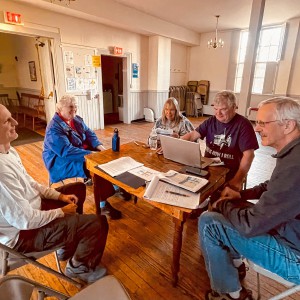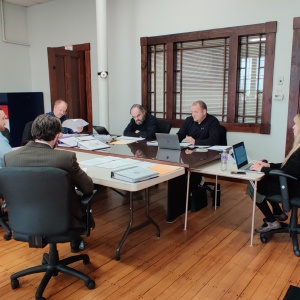Local author gives history talk on early Rindge
| Published: 03-27-2023 11:06 AM |
Jim Critser, a local historian who researches Rindge history, presented some of the facets of his latest research project and book, “Rindge: As it was in 1816” for an audience at the town’s historic Meeting House last week, in what he said was just a glimpse at his most recent book.
Crister researched Rindge from 1600 through 1816 while researching this project, but for the purpose of the talk, which was presented by the Ingalls Memorial Library on Friday, he focused on three elements that he delves into in the book: the development of Rindge’s roads, Cutter Mill, and the development of the wool industry in Rindge.
Critser said he focused in on the year of 1816, because of a side project looking into the history of Rindge’s roads, when they were built, and what was on them. One of the early maps he found was dated 1816.
One of the earliest roads in Rindge, that was a road and not a path, was the Rindge Turnpike, built in 1807, to navigate around the hills in town.
Crister showed an early photograph of a cattle drive on the road, which, despite being one of the main thoroughfares, was still rutted and rough.
“This was a good day,” Crister said.
Most of Critser’s talk focused on a single area of the town – the area known as Cutter Hill Road today, but was sometimes referred to as “The Corner.”
The area is interesting, Critser said, as both a home for some of the town’s prominent persons of the day, and as a center of industry, being home to the Cutter’s Mill.
Article continues after...
Yesterday's Most Read Articles
The mill was names “Cutter’s Mill” around 1875, and was previously located at 44 Cutter Hill Road, thoughit no longer stands today.
The original building was built in 1790, and throughout the years, was operated by as a saw mill by James Bennett, a carding mill to process wool fibers by Eben Brown, and then a Bobbin Mill by Silas Coffin. It was also operated as a carriage shop by Ebenezer B. Cutter, where the mill gets its name.
Ebenezer Bancroft Cutter lived from 1837 until 1892, and had an occupation as a wheelwright – making cart and wagon wheels. He came to Rindge from Jaffrey in about 1860, when he married Ann Judson Bennett, whose father James Bennett was a box maker in town.
Several of the industries that went through Cutter Mill are indicative of the New Hampshire sheep and wool boom, which took place from 1810 to 1840.
“It caused a huge explosion of industry in Rindge,” Critser explained.
Cutter Hill was something of an industrial zone for its time, Critser explained. In 1810, Rindge produced 27,190 yards of cloth – enough to stretch from Rindge to Jaffrey – despite processes being mostly by hand. In that same year, the town processed about 5,000 pounds of wool.
In 1810, according to census information, Rindge had 544 spinning wheels – a common home industry – 130 weaving looms, a carding machine, which was housed in the Cutter Mill, three tanners, six smith forges, three corn mills, and four saw mills, though Critser said at its height, Rindge had seven saw mills.
The industry, particularly around the Cutter Hill Road area, is attributed to Rindge’s water ways, Critser explained.
“The main thing that made this work was water power,” Critser said.
Rindge’s water power came from the flow from Emerson Pond to one of two sources – Crowcroft Pond or Converse Pond – and then to Lake Monomonac. The varied elevations caused the water to flow downhill and powered the mills.
Critser’s history books are available for sale at the Ingalls Memorial Library. Proceeds from the sales go to benefit the Rindge Historical Society.
Ashley Saari can be reached at 603-924-7172 ext. 244 or asaari@ledgertranscript.com. She’s on Twitter @AshleySaariMLT.

 Group looks to close divide in Mascenic district
Group looks to close divide in Mascenic district Rindge Recreation Department organizes a trip to Converse Meadow
Rindge Recreation Department organizes a trip to Converse Meadow Greenfield Community Power Committee approves identifying possible suppliers
Greenfield Community Power Committee approves identifying possible suppliers Wilton Select Board discusses options for ARPA funds
Wilton Select Board discusses options for ARPA funds
